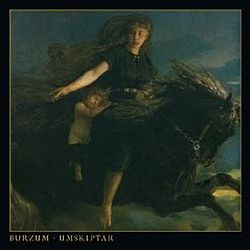Umskiptar
| Umskiptar | ||||
|---|---|---|---|---|
| Studio album from Burzum | ||||
|
Publication |
2012 |
|||
| Label (s) | Byelobog Productions | |||
|
Format (s) |
CD, LP |
|||
|
Title (number) |
11 |
|||
|
running time |
64 min 25 s |
|||
|
Varg Vikernes (producer), Eirik Hundvin (recording and mix) |
||||
|
Studio (s) |
Grieghallen Lydstudio |
|||
|
||||
Umskiptar ( Old Norse 'Metamorphosis') is the ninth studio album of the extreme metal project Burzum , released on May 21, 2012 by Byelobog Productions.
Emergence
Like its predecessors, the album was recorded in Eirik Hundvin's Grieghallen Lydstudios in Bergen at the end of 2011 . Hundvin was involved in the recordings as a sound engineer . Varg Vikernes himself produced the album and was responsible for all instruments and all of the vocals.
The album was leaked two months before its official release , allegedly because its former PR agent had sent promo CDs to a " far-left " magazine. According to Varg Vikernes , a Swede was responsible for the leak.
The album was released in the CD version as both a jewelcase and a digipak . Distribution in Europe was published by Vikernes' own label Byelobog Productions (distributed by Plastic Head ). The US version is from Candlelight Records . There are a total of three versions of the album on vinyl, all as double LPs. They differ in the color of the vinyl and the inserts. The LP versions were released on the British label Back on Black.
Track list
- Blóðstokkinn - 1:10
- Jóln - 5:46
- Alfadanz - 9:18
- Hit Helga Tré - 6:47
- Era - 3:54
- Heiðr - 2:57
- Valgaldr - 7:57
- Galgviðr - 7:12
- Surtr Sunnan - 4:11
- Gullaldr - 10:14
- Níðhöggr - 4:59
Music style and concept
Varg Vikernes called the album "Scaldic Metal", also to avoid being called Black Metal , as his music is repeatedly described by his fans and critics. Vikernes has distanced himself from Black Metal and the associated scene since the 1990s.
The album title is Norwegian for ' metamorphosis '. The lyrics of the album were taken from a poem from the Nordic Middle Ages with the name Völuspá (Eng. 'Prophecy of the Seer') and are in Old Norwegian . On the album, Vikernes renders the 66-verse poem within eleven songs, using elements of Black Metal, Heavy Metal , but also post-rock or the ambient sounds of the albums Hliðskjálf and Dauði Baldrs . Vikernes' musical implementation of the poem is based on his own interpretation of the poem, which he also presented in his book Sorcery and Religion in Ancient Scandinavia .
The album is mainly characterized by heavy, slow doom metal - riffs . Vikernes' singing is in Norwegian and mostly clear. Several times it is depicted as a whisper or in a baritone . His guttural singing , known from Belus , can also be heard, and some stanzas are transposed as recitative . Some of the songs are underlaid with sound effects, such as field noises, bass drum and a trumpet with feedback to simulate a kind of battle, in Níðhöggr .
Vikernes described this album as a way back to basics, prioritizing atmosphere and wholeness. For him it expresses a European, pagan concept of change, that of an impending new ice age . In addition, the album is a criticism of the current political movements.
reception
Due to the musician's open right-wing extremist attitude, which he publicized in numerous pamphlets and appeals, his album was largely ignored by the established press. In contrast, there were isolated reviews on the Internet that ranged from benevolent to negative.
Grayson Currin of Pitchfork Media criticized the album for lack of structure and direction. Although there are some interesting musical elements, the album is superfluous and a sign of the dismantling of his band. The album is simply boring and unspectacular.
Rüdiger Stehle from Powermetal.de, on the other hand, describes the album as "a concept work designed with great attention to detail, which, however, seems a bit distant."
Fafnir from Alternative Music Webzine Terrorverlag described the album as a mixture of Varg Vikernes' different creative phases:
“BURZUM proves once again how you can create songs full of fervor, atmosphere, depth and raw mood with the simplest and most basic means. So on 'Umskiptar' you can find references to the raw early days as well as to the later albums that crossed into the ambient direction. In doing so, Vikernes does not sound out any of these individual extremes, but now seems to have found his style in which both the roots of Black Metal can be clearly heard, but also the ambient facets have taken their equal place. "
Individual evidence
- ^ Liner Notes
- ↑ a b Rafael Pérez: Interview with Varg Vikernes for Queens of Steel. Translated from Spanish by Burzum.com, April 14, 2012, accessed February 24, 2013 .
- ↑ a b c Kai Grimmsberg: Interview with Varg Vikernes. Burzum.org, April 29, 2012, accessed February 24, 2013 .
- ↑ Burzum - umskiptar. Discogs , accessed February 24, 2013 .
- ↑ a b Grayson Currin: Burzum: Umskiptar. Pitchfork media, June 8, 2012, accessed February 24, 2013 .
- ↑ a b Rüdiger Stehle: BURZUM - Umskiptar. Powermetal.de, May 25, 2012, accessed on February 24, 2013 .
- ↑ Varg Vikernes : Burzum "Umskiptar" 2012. Burzum.com, accessed on February 24, 2013 .
- ↑ Fafnir: BURZUM - umskiptar. Terrorverlag.de, May 8, 2012, accessed February 24, 2013 .

